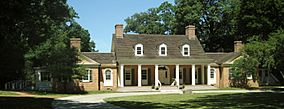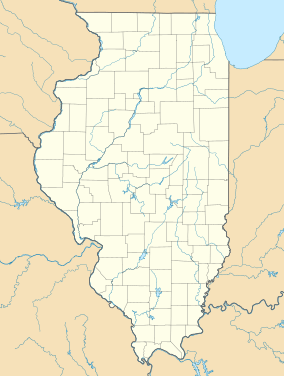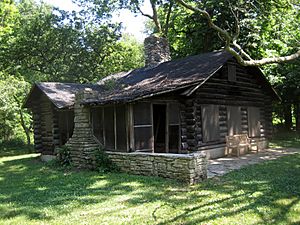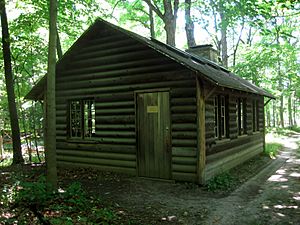Edward L. Ryerson Conservation Area facts for kids
Quick facts for kids Edward L. Ryerson Conservation Area |
|
|---|---|

Ryerson's country house
|
|
| Location | Riverwoods, Lake County, Illinois, United States |
| Established | 1966 |
| Named for | Edward L. Ryerson |
| Governing body | Lake County Forest Preserves |
| Website | Edward L. Ryerson Conservation Area |
The Edward L. Ryerson Conservation Area is a special protected area and a historic district in Riverwoods, Illinois, United States. It was once a peaceful weekend getaway for Edward L. Ryerson, a successful businessman. He built his first cabin here in 1928.
Later, he added three more cabins for his friends. In 1942, a larger country house was built. This area was a popular escape for wealthy people from Chicago. They came here to enjoy the quiet beauty of the Des Plaines River. The Ryerson family later gave this land to the Lake County Forest Preserve district. Now, everyone can enjoy its natural beauty. About 471 acres of the area are known as the Edward L. Ryerson Area Historic District.
Contents
A Special Place in Nature
How It All Started
The Des Plaines River area became a popular spot for relaxing in the early 1920s. Three cabins were built along the river between 1923 and 1928. They belonged to wealthy businessmen named Frederick A. Preston, Everett L. Millard, and Cecil Barnes. All of them lived in the North Shore area of Chicago.
Cecil Barnes was a friend of the Ryerson family. He introduced them to the idea of having a cabin here. Edward L. Ryerson bought about 28 acres of land next to Barnes' property. He built his own cabin in 1928. At that time, Ryerson had just become the president of the Ryerson Steel Company. He was also in charge of the Chicago Council of Social Agencies.
The Ryerson Farm and Country House
In 1938, a large piece of land next to Ryerson's property was put up for sale. Ryerson worried that this 250-acre lot would be developed. He feared it would ruin the peaceful surroundings of his cabin. Ryerson, who was now president of the Inland Steel Company, decided to buy the land himself. He planned to create a farm there.
Ryerson hired Edwin Hill Clark, an architect from the North Shore, to design the farm buildings. Clark designed a dairy barn and a building for farm equipment. It's believed he also designed the farmhouse and two sheds. Ryerson bought a herd of Guernsey cattle for milk. But he soon found milking them too much work. So, he sold the dairy cows and bought beef cattle, hogs, and Arabian horses instead.
While waiting for the farm to be built, a big storm in 1938 destroyed the Ryerson family's vacation home in Massachusetts. Ryerson then decided to build a new country house on his large property in Illinois. He hired Ambrose Cramer to design the house. It was built in the Greek Revival style, which looks like ancient Greek temples. Cramer was chosen because he lived in Galena, a city with many Greek Revival homes.
Other Cabins and Their Owners
Hermon Dunlap "Dutch" Smith, a company vice president, bought 8 acres east of Barnes' property. He built his cabin near the river in 1935. Smith loved the area so much that he wrote a book about the Des Plaines River in 1940.
Architect Ambrose Cramer built his own cabin in 1940 while designing Ryerson's house. However, he never used it, as he moved to Maine in 1942. His cabin was later moved north of Aptakisic Road in the 1970s. Chauncey Borland, a real estate executive, built a cabin on 15 acres in 1941. Artist Ivan Albright also built a cabin here in the 1950s.
Becoming a Public Forest Preserve
The Ryerson family later built a winter home in Palm Desert, California. By the 1950s, they started spending their vacations there instead of at the cabin retreat. In 1966, Ryerson donated 85 acres north of Aptakisic Road to the new Lake County Forest Preserve District. Over time, the Ryerson family's donations totaled 257 acres.
Edward Ryerson also convinced the other landowners to donate their properties. Ivan Albright sold his land in 1968. Henry Preston, Frederick's son, sold 15 acres and his cabin in 1969. David Dangler, who owned the Millard property, sold 7 acres to the district the next year. Chauncey Borland donated his land in 1985. The forest preserve moved Borland's cabin north of Aptakisic Road to use as a visitor center. The cabins of Millard, Barnes, and Preston were eventually taken down. By 1972, the Forest Preserve covered about 550 acres.
Today, the forest preserve is about 561 acres. It has 6.5 miles of trails for hiking and cross-country skiing. The 2.5-mile Ned Ryerson Trail is named after Ryerson's son. It is wheelchair accessible and has an audio guide for people who are visually impaired. More than half of the land is protected as an Illinois Nature Preserve.
A Historic District
On February 29, 1996, about 471 acres of the forest preserve were recognized as a historic district. This was done by the National Park Service. It means the area is listed on the National Register of Historic Places. This special recognition includes the land Ryerson owned by 1945.
The historic district includes ten buildings, one site, one structure, and three objects. These all help tell the story of the area's past. The buildings include most of the farmstead, the country house, and four of the five remaining cabins (Albright's cabin is not included).




